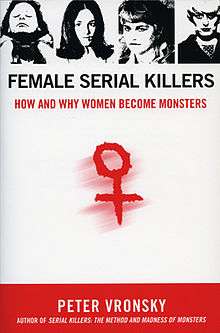Female Serial Killers
 | |
| Author | Peter Vronsky |
|---|---|
| Language | English |
| Genre | True crime History |
| Publisher | Berkley Books Penguin Group |
Publication date | 2007 |
Published in English | 2007 |
| Pages | 496 |
| ISBN | 0425213900 |
| OCLC | 123390943 |
Female Serial Killers: How and Why Women Become Monsters is a non-fiction true crime history by Peter Vronsky, a criminal justice historian. It surveys the history of female serial killers and female-perpetrated serial homicide, its culture, psychopathology, and its investigation from the Roman Empire to the mid-2000s.[1]
The book describes historical cases of female perpetrated serial murder from early recorded instances in ancient Rome to medieval and Renaissance Europe, Victorian Britain and its rise and escalation in the United States and the world in the postmodern era. Vronsky's central contention is that female serial killers, while exhibiting different forensic 'signatures' from male counterparts, inevitably kill for the same reasons that male offenders do: for power and control. The major difference, according to Vronsky, between female and male serial killers is that females (unless partnered with a male offender) tend not to sexually assault or physically mutilate their victims.[2][3][4]
Vronsky cites statistics that indicate one in nearly every six (16 percent) serial killers apprehended in the United States since 1820 was a female, either acting alone or as a partner of a male or female offender.[5] Vronsky argues that contrary to popular belief that female serial killers prefer to murder their male intimates or family members, recent data indicate that currently female serial killers marginally prefer strangers as victims[6] and that historically in the United States, 53 percent of female serial killers had murdered at least one adult female and 32 percent at least one female child.[7]
Reviews of the book by readers on Amazon.com and Goodreads.com argue on Vronsky's assessment of the politics of radical feminism in the context of predatory female behavior vs. female victimization, and, in particularly, his harsh criticism of radical feminist Phyllis Chesler and her role in the failed and highly politicized trial defense of female serial killer Aileen Wuornos as herself a victim of systemic male aggression. Charged in the predatory serial murders of seven male victims, Wuornos a Florida sex worker claimed that each one had attempted to rape her during their encounters with her and her killing them was an act of self-defense. [8][9]
References
- ↑ Female Serial Killers by Peter Vronsky | PenguinRandomHouse.com
- ↑ Frank S. Perri & Terrance G. Lichtenwald, "The Last Frontier: Myths & the Female Psychopathic Killer", Forensic Examiner, Summer 2010. http://www.all-about-forensic-psychology.com/support-files/female-psychopathic-killers.pdf
- ↑ Kimmon Ianneta and Reed Hayes, "Women Who Kill", Perfect Advice Handwriting Evaluation, http://perfect-advice.com/?page_id=1036
- ↑ Glenn D. Wilson, Profiling a Killer, Gresham College, London - Museum of London Lecture, 20 March 2012 - http://www.gresham.ac.uk/lectures-and-events/profiling-a-killer; David Wilson, Elizabeth Yardley, (2013) "The psychopathy of a Victorian serial killer: integrating micro and macro levels of analysis", Journal of Criminal Psychology, Vol. 3 Issue: 1, pp.19-30; Rosa Aiello, "Guilty of a double standard", McGill University Daily, November 12, 2009. http://www.mcgilldaily.com/2009/11/guilty_of_a_double_standard/
- ↑ Peter Vronsky, Female Serial Killers: How and Why Women Become Monsters, New York: Penguin Group Berkley Books, 2007. p. 3
- ↑ Vronsky, p. 29
- ↑ Peter Vronsky, p. 15.
- ↑ Amazon.com: Customer Reviews: Female Serial Killers: How and Why Women Become Monsters
- ↑ Female Serial Killers: How and Why Women Become Monsters by Peter Vronsky — Reviews, Discussion, Bookclubs, Lists